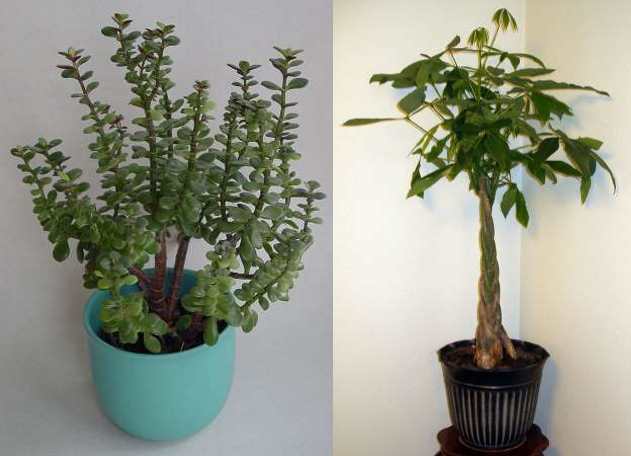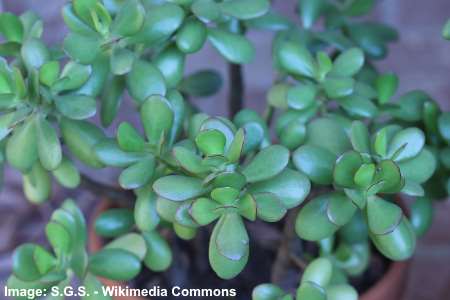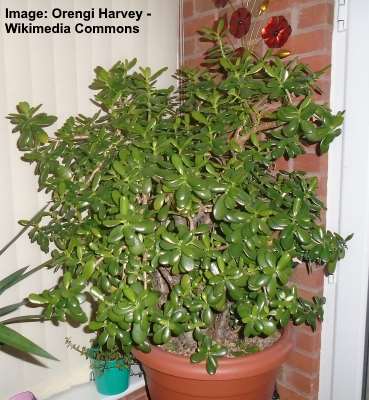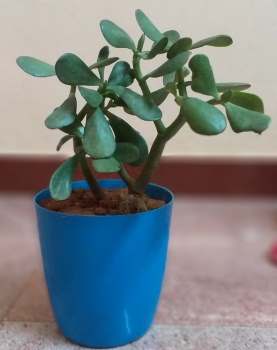The money plant, Crassula ovata, is a jade plant that is widely recognized. This type of jade plant is known as the money plant in Chinese Feng Shui because it brings good luck, wealth, prosperity, and good fortune. This small tree-like jade plant is a common houseplant because it is so easy to care for.
Jade plant, or Crassula ovata, is a woody succulent plant that belongs to the Crassulaceae family. The jade-green color of the leaves gave the plant its name. These jade-colored leaves may blush crimson near the margins after being exposed to direct sunlight. Dollar-plants are another name for jade plants.
Jade plants have a reputation for remaining long-lived, with some specimens surviving up to 100 years. The jade plant develops a thick woody stem and branches as it grows older, giving it the appearance of a tree, which some people nickname it money tree plant. This tree-like money plant has coin- or ovate-shaped fleshy leaves that produce lush succulent foliage.
This “lucky plant” thrives in most indoor conditions, which is the thing about it. Jade plants flourish under artificial light and can tolerate minimal watering. Jade plants are simple to raise, and your money plant may take on a bonsai-like look with some care. It’s a popular gift at weddings, homewarming parties, and for new business owners because it’s a Feng Shui money plant.
Jade plants are said to generate positive energy and produce feelings of equilibrium, peace, and well-being as their vibrant growth.
Types of Money Plants
The jade plant, also known as the money plant, is one kind of money plant, while the Pachira Aquatica is another kind of money tree or lucky tree. A braided stem is frequently included with the money tree, which is an decorative houseplant. The stems are tall and the leaves are lanceolate-shaped, growing from the top.
The jade plant Crassula ovata is often called the money tree, but it is not the “real” good luck tree. The Feng Shui claims that the Crassula ovata species attracts money over 300 different jade plants. One of the popular Feng Shui lucky plants is Jade Crassula ovata.

Crassula ovata has a tree-like appearance and is known as the jade plant or money plant. Pachira Aquatica (money tree plant) on the right. According to Feng Shui, both plants are thought to bring good luck.
How to Take Care of a Money Plant
Your money plant will thrive for many years if you give it the care and attention it needs. This ensures that wherever you place your “good luck plant,” it will produce a happy atmosphere. Read on to learn how to care for your jade plant properly rather than leaving it up to chance.
How to water a jade tree plant
To encourage healthy development, jade plants need the correct watering. They are a succulent species. Jade tree plants shouldn’t be left to go completely dry for long periods, even if they can withstand occasional watering. It’s also vital not to water your jade plant too much. Roots rot due to too much moisture, and leaves may begin to fall. As the leaves begin to soften and mushy, it’s a sign that you’ve overwatered. Therefore, wait until the soil dries before watering again.
The soil is the best way to determine how often to water your jade plant. Before watering the soil, you should make sure that it is nearly dry. As a result, the length of time you need to water your money plant varies with the season: in summer, you may have to water it every week, while in winter, just once or twice.
Pour water directly into the soil until it drains out the bottom to water your jade plant. Before watering again, allow the land to dry out.
Light requirements of jade tree

The edges of your money plant’s jade tree leaves get a little reddish as a result of the light. Jade plants may flourish in the presence of artificial light, but full sun and part shade will produce a bushier shrub. Aim to place your money plant in full sunlight for 5 hours each day to get the best results.
You might also note that the edges of jade-colored leaves become slightly reddish when they are exposed to a lot of sunlight. It could be a indication that the sunlight is too harsh if the leaves turn a yellow or deep purple color. Therefore, to acclimate the plant, move it into the shade and gradually expose it to sunlight.
When your jade plant becomes leggy, it’s a indication that it needs more light. If you do, move the jade plant to a more sunny location and energize the room by trimming it back.
Feeding your jade plant
You’ll need to apply some all-purpose fertilizer to your Chinese lucky plant from time to time. During the growing season, all you need is a general feed for houseplants and switch it every 3–4 months. Water your succulent jade plants first, then give them the all-purpose houseplant fertilizer; this is the best way to keep them well-nourished. This will help the plant grow better by preventing root damage.
Proper growing environment for money plants
Jade trees are succulents that may be grown both indoors and out. They are one of the most demanding houseplants to maintain. Indoor environments appear to be beneficial for succulent money trees. Temperatures of 65 to 75°F (18 to 24°C) are ideal in the day. While jade plants can withstand occasional freezes, it’s important to keep the temperature above 50°F (10°C) on a regular basis.
Proper growing environment for money plants

Jade plants are one of the simplest to look after sorts of houseplants, and they may be found both indoors and outdoors. Indoor environments seem to be suitable for succulent money trees. Between 65 and 75°F (18 and 24°C) is the optimum temperature for a room during the day. Make sure that the temperatures don’t routinely drop below 50°F (10°C) for jade plants, even if they can tolerate the odd freeze.
Repotting jade tree

Your lucky money plant, which looks like a tree, can survive in the same pot for years without being repotted. Repot your money maker plant in the spring if you believe it has outgrown its pot. If you rely on free-draining soil and only water your money plant when it resumes its development, it will reward you with fresh growth.
Cutting and pruning a jade plant

Jade money plants grow to be between 3.2 and 5 feet (1.5 and 1.5 meters) tall when pruned properly. Crassula ovata plants have been reported to grow as tall as 16 feet (5 meters) tall, according to some sources. If you want to keep it indoors, you must cut and prune it frequently to maintain a healthy money shrub. Any dead leaves from the plant should be removed as well. Prune your money tree when it begins to sprout in the springtime.
To create the form you want, cut off overgrown branches or remove branches. Your jade plant may develop into a miniature succulent bush or indoor tree if you do this. If you want to control how tall your jade plant grows, you can also cut off up to one-third of its height.
Pruning the roots of your jade plant is another way to keep it from becoming too tall. Next, remove the money plant from its pot and just chop off one-third of the roots to accomplish this. Jade bonsai trees can be grown for Feng Shui using root pruning.
Dusting
Dusting your jade plant occasionally is another important way to care for it. To remove dust from the glossy green leaves, use a slightly moist cloth. Because wet leaves may rot, try to keep them as dry as possible. When you water your money plant, avoid getting the leaves too wet by keeping them away from water.
How to Propagate a Jade Plant

Jade plants may be propagated using both leaf and stem. You’ll get juvenile jade plants in tiny pots fairly quickly since jade plants are hardier. Cutting off a few healthy-looking leaves is the simplest way to spread a money plant. Allow the cuttings to dry at both ends. After that, all you have to do is put the jade cuttings in soil. Your baby jade should then start growing into a small money plant after roots form around 4 weeks after planting.
One of the stems might also be used to propagate a jade plant. Allow the end of the stem to dry out completely, similar to the jade leaf propagation method. Make sure that the soil supports the stem of the cutting before putting it in.
Common Problems When Growing Money Plants (Jade Tree)
Aphid, spider mite, and mealybug infestations are among the most common problems with jade plants. Scale insects affect plant development and may deformate plants in the genus Crassula. Dipping a cotton bud in rubbing alcohol is the most effective way to eliminate pests from your money plants.
To exterminate the insects, simply apply to them! Keep reapplying every day to kill new pests or eggs. Over-watering your jade plant is usually indicated by soft leaves. Water less often to address this difficulty. That might mean you are watering more often if you see wrinkled leaves.
Common Questions Related to Growing Jade Tree (Money Plant)What else should you know about caring for a jade money plant tree? The following are answers to some of the most common questions:
How do you save a dying jade plant?
It’s critical to determine the source of the problem if your succulent jade plant is starting to die. You should adjust your watering schedule appropriately if under or over-watering is the cause. Leaf drop, poor growth, and leaf spotting are all signs of watering problems. Take some rubbing alcohol to remove mealybugs or other insects from your jade plant if you notice them.
How do I make my jade plant thicker?

With the appropriate pruning, you may create a dense bushy appearance that resembles a little tree. Where you want increased foliage to develop, pick a stem. Just above one of the brown rings, prune the woody stem. This will help your jade plant appear thicker by causing two additional stems to develop.
Getting a leggy jade plant to have a fuller, healthier look can also be done by pruning in this manner. Make sure your jade plant is kept out of drafts and gets between 4 and 6 hours of sunlight every day to help it grow fuller, healthier, and faster.
How do I get my jade plant to bloom?

Jade plants produce delicate star-shaped pinkish-white blooms when they are in bloom and are a flowering succulent. To get your money plant to blossom, you don’t need Luck involved. Before it blooms, your jade plant must grow for a few years and develop.
Stopping watering your plant and transferring it to a dry condition is one way to encourage blooming. Next, you’ll want to keep the temperature indoors low, around 60°F (12°C) throughout the evening. When jade plants bloom, this helps to replicate their native environment. It’s possible that you’ll have to wait a few more years if you’ve tried this and your jade plant hasn’t responded well.
Do jade plants grow fast?
The fastest-growing kind of plant is not jade. They take a long time to grow, with mature jade trees frequently exceeding 50 or 60 years old. Making certain that you have the optimum growing circumstances is the greatest way to promote your indoor jade plant’s development. When your potting soil dries out, you must get enough sunlight, keep in a warm, humid atmosphere, and water your potting plant.
Where should you place a jade plant in your house?
Any draft-free, bright, and temperature-controlled room in your home may be used to house jade plants. Lucky money plants, according to Feng Shui, should be placed in the southeast corner of your house. Inviting luck, good fortune, and wealth is supposed to be done in this manner. Feng Shui recommends placing a jade money plant on a desk or at an entrance door to attract more wealth to your business.
Does my jade plant like to be misted?
To raise humidity, mist your jade plant leaves. Misting is not required if you reside in a humid environment. If you want to avoid your money plant’s leaves falling off or root rot, simply ensure that it gets enough water.
How long to jade plants live?
According to botanists, jade plants may survive up to 100 years and are native to South Africa.
Where do jade plants grow?
In warm regions such as California, Mexico, Spain, South Africa, Australia, and New Zealand, jade plants thrive outdoors. Jade plants, which are also known to bring prosperity and good luck to their owners, are also lovely indoor decorative houseplants.
